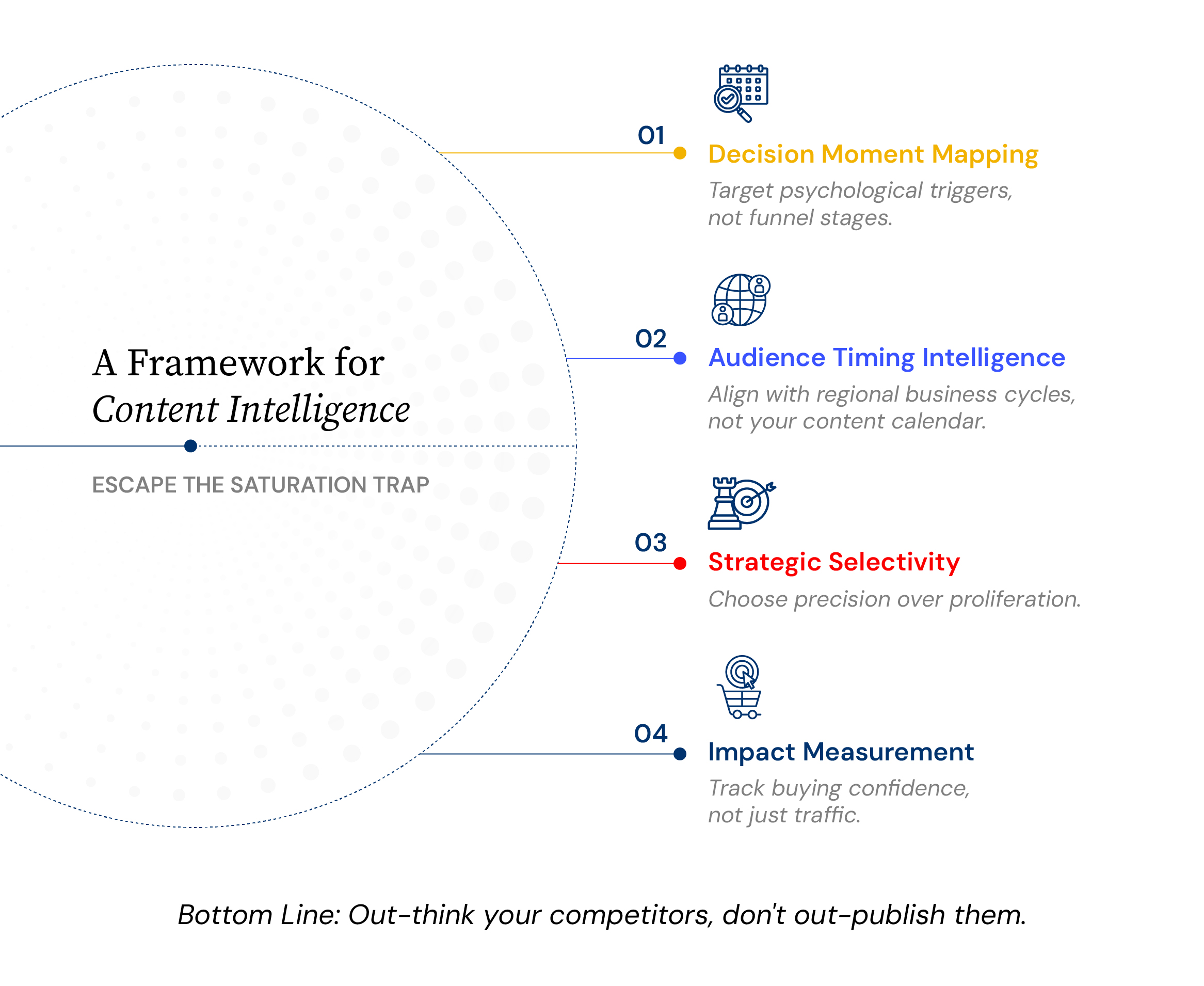Summary
The content saturation paradox reveals that volume-based approaches often undermine content strategy effectiveness. Strategic content planning focused on decision psychology and audience timing consistently outperforms high-frequency publishing for B2B marketing success.
B2B buyers are experiencing cognitive overload from content proliferation. Companies dramatically increasing content production often see declining engagement—strategic content planning now matters more than volume and variety.
The content production obsession
“We’ve 10x’d our content production!” marketing teams announce with genuine pride. Content calendars stretch months ahead. Publishing schedules rival major media outlets. Every social platform gets its daily dose.
Meanwhile, engagement rates decline steadily. Sales teams complain that prospects show up to calls less informed than expected. Your carefully planned content isn’t translating into effective B2B lead generation.
Here’s what most teams don’t want to acknowledge: Your content strategy might be creating confusion rather than clarity for your target b2b buyer.
When “more” became the default answer
The content marketing industry has built its foundation on a compelling premise: more content equals more influence. Industry experts advocate daily publishing, platform omnipresence, and content for every buyer journey moment (because modern buyers apparently need constant nurturing).
But this approach often produces cognitive overload that actively repels the people you’re trying to attract.
Modern B2B buyers consume multiple pieces of content before making purchase decisions. That sounds substantial until you realize those pieces aren’t randomly sampled from your entire content library. They’re hyper-specific, contextually relevant, and perfectly timed to psychological decision moments.
When you’re consistently publishing across all channels, you’re not necessarily increasing the odds prospects will find those crucial pieces. You might be making them harder to discover.
The strategic scarcity approach
While most content marketers advocate daily publishing, the smartest companies are taking a different approach: fewer pieces with higher impact through strategic content planning.
Working with a quality engineering company over six years revealed something counterintuitive. The content that generated the most meaningful engagement wasn’t produced during our highest-volume publishing periods. Instead, breakthrough moments came when we focused on decision-relevant timing rather than calendar consistency.
[Based on experience: transformation from minimal content to over 1,000 published pieces over six years]
The transformation taught us that strategic precision outperforms publishing frequency. Quality engineering prospects didn’t need daily thought leadership—they needed the right insights at exact moments when they were evaluating solutions for their B2B marketing challenges.
The timing intelligence factor
Here’s where most approaches encounter serious challenges: assuming all audiences consume information on the same schedule.
Different markets have different information consumption patterns that don’t align with standard publishing calendars. Working across diverse regional markets revealed timing expectations that dramatically affect content effectiveness.
What worked in one region produced significantly higher costs and disappointing engagement in another—not because content quality differed, but because the timing didn’t match audience expectations.
[Based on experience: 67% higher costs observed in Eastern vs South Indian markets]
Some markets responded to content tied to business cycles and industry events. Others needed alignment with academic seasons or government initiative timelines. The pattern was clear: audience timing intelligence mattered more than publishing frequency.
This insight proved crucial for developing effective localized marketing approaches that resonated with regional business cultures and decision-making patterns.

A framework for content intelligence
Decision moment mapping: Identify specific moments when prospects transition from exploration to evaluation. Create content for those moments, not arbitrary funnel stages. This forms the foundation of any effective content marketing strategy.
Audience timing intelligence: Understand how different markets consume information. Time content to match cultural decision cycles, not publishing calendars. This principle applies whether you’re developing content for local markets or international expansion.
Strategic selectivity: Produce fewer pieces with higher precision. One piece perfectly addressing a decision trigger often outperforms multiple pieces broadly covering related topics. (This requires discipline in your marketing framework.)
Impact measurement: Track decision velocity and buying confidence rather than vanity metrics like page views and social shares. Focus on how content influences actual B2B sales outcomes.
The effectiveness reality
A sustainable mobility platform connecting diverse stakeholder groups demonstrated this principle effectively. Instead of comprehensive coverage, we focused on trigger-specific pieces addressing precise moments when different stakeholders shifted from passive interest to active evaluation.
Result? A small-budget campaign generated significant qualified leads. Not through content volume through surgical precision.
Innovation managers responded to workflow efficiency solutions rather than company-wide transformation messaging. Startup founders converted based on access frustrations, not strategic positioning. Industry experts engaged around professional validation needs, independent of their employers’ characteristics.
The campaign succeeded through individual psychology understanding, not comprehensive content coverage.
The strategic reality
Content saturation creates diminishing returns. B2B buyers experiencing cognitive overload respond better to strategic scarcity than information abundance. Effective strategies focus on decision triggers, audience timing, and precision rather than volume, frequency, and comprehensive coverage.
Companies creating fewer, more strategically timed pieces consistently outperform those maintaining high-frequency publishing schedules. Strategic intelligence about what prospects actually need determines content effectiveness.
The paradox reveals itself clearly: More content often produces less impact because cognitive overload reduces buying confidence instead of building it.
The solution isn’t to out-publish competitors, it’s to out-think them through superior content planning that addresses real decision triggers rather than imaginary content gaps.
Key Takeaways: Effective content strategy prioritizes targeting real decision moments and audience timing over generic funnel stages and publishing calendars to drive true buying confidence in B2B markets. A strategic content strategy focuses on precision and impact measurement.






